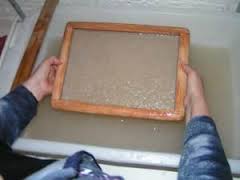Maybe we just stole the idea of wasps: chewing wood fibers or plant fibers with saliva, making a layer with them, and letting them dry.
 In 105 the Chinese eunuch Ts'ai Lun invented paper. The production was a closely guarded state secret. Only in 1144 the production reached via Spain Europe too.
In 105 the Chinese eunuch Ts'ai Lun invented paper. The production was a closely guarded state secret. Only in 1144 the production reached via Spain Europe too.
In the 5th century, Mexico had already paper. The Aztecs made thick paper of palm leaves, agave or fig bark. The codex Fejervary - Mayer has survived six centuries without any degradation.
With wet hammered fibers so you can make paper. You can also slam rags and waste paper to porridge. This is ladled into a with mesh stretched and tilted frame on a felt layer. The layers of felt- paper are pressed, whereafter the sheets were hung to dry.
Then they are still immersed in a bath with bone glue and alum, and dried again.
Nowadays the lignin in wood pulp is chemically removed.
As a filler chalk or kaolin is added, and sometimes also whiteners and a starch coating.
Paper is (thankfully) much recycled.
Use the blank backs of printed materials as scrap, printing and writing paper.
The Western European industry bleaches pulp rarely with chlorine (gas) now, but with chlorine dioxide, hydrogen peroxide or ozone.
To calculate the weight of an A4 piece of paper the weight indicated on the package must be divided by 16. A 80 grams A4 sheet thus weighs 5 grams. This has to do with the standard paper sizes.
Birch bark (inner birch bark) was also once used as writing material (paper).
In a text from 93 BC a Chinese imperial sentry recommends his prince to blow his nose with a piece of paper. This, tough paper was also used for clothing, blankets, arrow -proof vests and even shoes!
Were no trees here before? Yes. You certainly do not read newspapers? (Jan- Willem Overeem)
